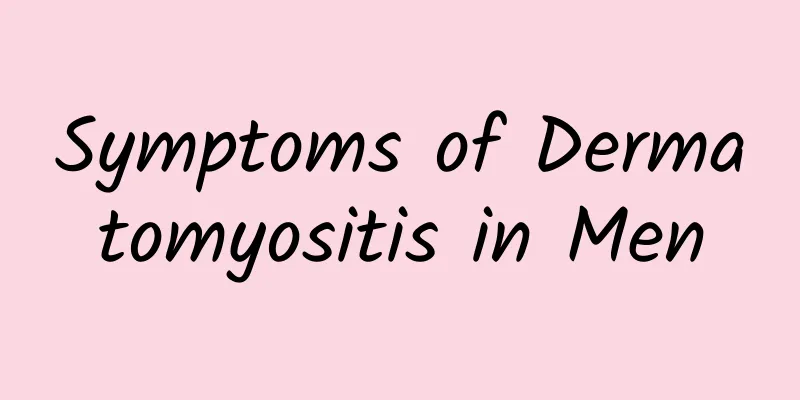Symptoms of Dermatomyositis in Men

|
Dermatomyositis is a common skin inflammation in our body, and it is common for both men and women to suffer from it. In fact, the incidence of this so-called dermatomyositis is also relatively high, so in reality many people have suffered from dermatomyositis or are suffering from dermatomyositis. There are many reasons for a person to suffer from dermatomyositis, and similarly, there are many symptoms of dermatomyositis. So, what are the symptoms of male dermatomyositis? For male friends, the probability of suffering from dermatomyositis is also very high, because many times, they will suffer from dermatomyositis due to problems with their living environment or their own living habits. The most important thing for male dermatomyositis patients is timely treatment, but in fact, after knowing the symptoms of male dermatomyositis, the hope of cure will increase a lot. 1. Skin symptoms: (1) Gottron's sign: Another common characteristic lesion is the occurrence of purple-red macules on the extensor surfaces of the elbows, knees, metacarpophalanges and interphalangeal joints. The surface is dry and has bran-like scales, which is called Gottron's sign. Purple-red flat papules covered with fine scales occur on the extensor surfaces of interphalangeal joints. After disappearance, atrophy, capillary dilation and hypopigmentation occur. However, this only occurs in 1/3 of patients and generally occurs in the late stage of the disease. (2) Periorbital purpura: Also known as heliotropic purpura, the characteristic skin lesion is a purple-red edematous patch centered on the upper eyelid. (3) Periungual capillary dilatation: Dark red spots and petechiae appear in the nail folds and they become thicker and coarser, which is also of diagnostic value. (4) Skin lesions in exposed areas: Erythema in the V-shaped area of the upper chest is also common. (5) Vascular atrophic heterochromia: Chronic cases may cause widespread erythema and papules, with a dry surface and bran-like scales, and may also cause punctate keratosis and patchy pigmentation and loss, mild atrophy, and dilated capillaries, which is called heterochromic dermatomyositis. 2. Muscle symptoms: Any part of the transverse muscles can be affected, usually symmetrically, with the proximal muscles of the limbs affected first, followed by other muscles. The most commonly affected muscles are the shoulder girdle muscles, proximal muscles of the limbs, neck muscles, and dermatomyositis (periorbital erythema) and throat muscles, with symptoms such as difficulty raising the hands, head, squatting, swallowing, and hoarseness. Involvement of the pharyngeal muscles can lead to tracheal foreign bodies and be fatal. When respiratory muscles and myocardium are affected, breathing difficulties, palpitations, arrhythmias, and even heart failure may occur. In the acute phase, muscle inflammation and degeneration cause muscle weakness and swelling, and the affected muscles have spontaneous pain and tenderness. Dermatomyositis in children can cause calcium deposits in the skin, subcutaneous tissue, near joints, and in the affected muscles. 3. Amyopathic dermatomyositis: Patients have skin manifestations of dermatomyositis that persist for 2 years without muscle lesions (such as lack of proximal muscle weakness, normal serum aldolase and CK). SLE, contact dermatitis, drug rash, etc. should be excluded during diagnosis. 4. Concomitant dermatomyositis and tumors: Dermatomyositis may be accompanied by malignant tumors, and the incidence of malignant tumors is 5 times higher than that of normal people. The incidence of malignant tumors in patients over 40 years old is about 30% to 50%. Malignant tumors mostly occur in the breast, nasopharynx, lung, gastrointestinal tract, ovary, cervix and prostate. Malignant tumors may occur at the same time as this disease, or later than this disease. In some cases, after the malignant tumors are treated and controlled, the symptoms of dermatomyositis are also improved accordingly. In summary, there are many symptoms of male dermatomyositis, which you will find from the above introduction. Although there are many symptoms of male dermatomyositis, the common symptoms are: many skin erythema and rashes; difficulty in limb movement, etc. For ordinary people, once they know the symptoms of male dermatomyositis, they will usually seek treatment in time. |
<<: Dietary treatment for prickly heat in men
>>: 4 Sex Mistakes That Will Scare Your Woman Away
Recommend
What color is a healthy glans?
The color of the glans penis varies from person t...
What causes acne on men's faces?
We know that acne is easy to grow on the face of ...
How to relieve prostate pain, diet therapy to relieve pain
Prostate pain can cause frequent and urgent urina...
What to do if you often stay up late and have bad breath? Adding something to porridge can solve the problem
Staying up late is a very harmful behavior, but m...
How can boys lose weight on both sides of their cheeks?
Although boys don't care too much about their...
Why can’t HIV be detected during the “window period”?
Many people are confused about the safety of bloo...
What causes low sperm forward motility?
If a man's sperm has low forward movement abi...
How does a boy's penis grow?
The penis is very important to boys and is relate...
What are the characteristics that men like most in women?
Recently, British sexologists summarized the fema...
What is the most effective way to quit smoking?
Everyone in the world knows that smoking is harmf...
What to use to clean glans inflammation
Penis inflammation is a male disease that often i...
Why does the smegma increase? There may be these reasons!
If men with severe foreskin are turned over, they...
Eight measures to improve men's sexual ability
1. Get enough sleep Many studies have confirmed t...
Are solid thyroid space-occupying lesions cancerous?
Many people know that the thyroid gland is the la...
What are the harms of long-term sitting to men?
Sitting for a long time has become a lifestyle fo...









